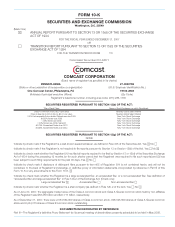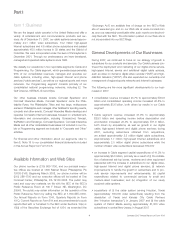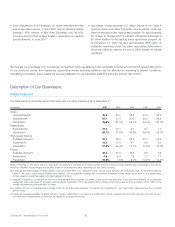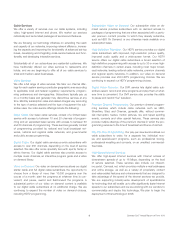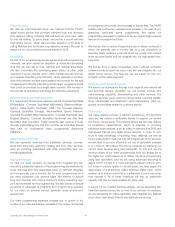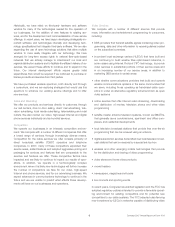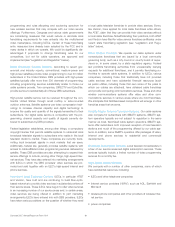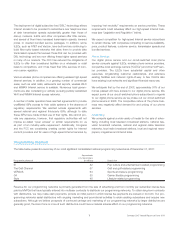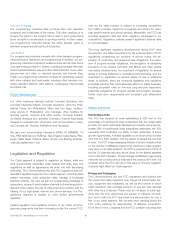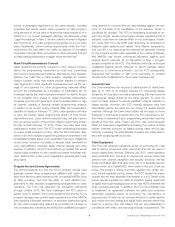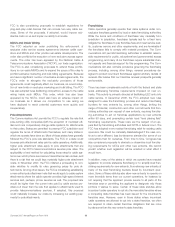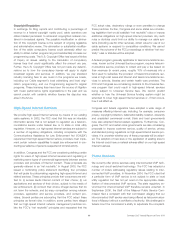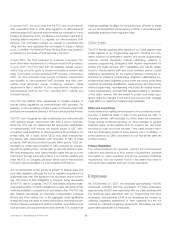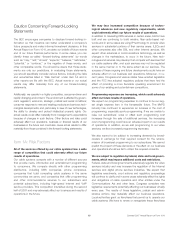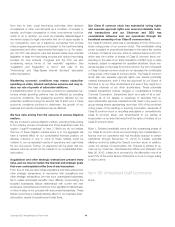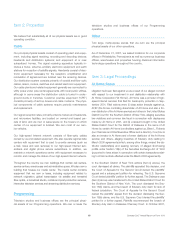Comcast 2007 Annual Report Download - page 7
Download and view the complete annual report
Please find page 7 of the 2007 Comcast annual report below. You can navigate through the pages in the report by either clicking on the pages listed below, or by using the keyword search tool below to find specific information within the annual report.Historically, we have relied on third-party hardware and software
vendors for many of the technologies needed for the operation of
our businesses, for the addition of new features to existing ser-
vices, and for the development and commercialization of new service
offerings. In recent years, we have begun developing strategically im-
portant software and technologies internally and developing tech-
nology specifications that integrate third-party software. We are also
expanding the use of open technology solutions that allow multiple
vendors to more easily integrate with our technology. We have
arranged for long-term access rights to national fiber-optic-based
networks that we actively manage to interconnect our local and
regional distribution systems and to facilitate the efficient delivery of our
services. We expect these efforts to continue and to expand in the
future. Our internal development efforts require greater initial
expenditures than would be required if we continued to purchase or
license products and services from third parties.
We have purchased wireless spectrum, both directly and through
a consortium, and we are exploring strategies that would use this
spectrum to enhance our existing service offerings and to offer
new services.
Sales and Marketing
We offer our products and services directly to customers through
our call centers, door-to-door selling, direct mail advertising, tele-
vision advertising, local media advertising, telemarketing and retail
outlets. We also market our video, high-speed Internet and digital
phone services individually and as bundled services.
Competition
We operate our businesses in an intensely competitive environ-
ment. We compete with a number of different companies that offer
a broad range of services through increasingly diverse means.
Competition for the cable services we offer consists primarily of
direct broadcast satellite (“DBS”) operators and telephone
companies. In 2007, many of these competitors expanded their
service areas, added features and adopted aggressive pricing and
packaging for services and features that are comparable to the
services and features we offer. These competitive factors have
impacted and are likely to continue to impact our results of oper-
ations. In addition, we operate in a technologically complex
environment where it is likely new technologies will further increase
the number of competitors we face for our video, high-speed
Internet and phone services, and for our advertising business. We
expect advances in communications technology to continue in the
future and we are unable to predict what effects these develop-
ments will have on our businesses and operations.
Video Services
We compete with a number of different sources that provide
news, information and entertainment programming to consumers,
including:
• DBS providers that transmit satellite signals containing video pro-
gramming, data and other information to receiving dishes located
on the subscriber’s premises
• incumbent local exchange carriers (“ILECs”) that have built and
are continuing to build wireline fiber-optic-based networks, in
some cases using Internet Protocol (“IP”) technology, to provide
video services in substantial portions of their service areas and
in an increasing number of our service areas, in addition to
marketing DBS service in certain areas
• other wireline communications providers that build and operate
wireline communications systems in the same communities that
we serve, including those operating as franchised cable oper-
ators or under an alternative regulatory scheme known as open
video systems
• online services that offer Internet video streaming, downloading
and distribution of movies, television shows and other video
programming
• satellite master antenna television systems, known as SMATVs,
that generally serve condominiums, apartment and office com-
plexes, and residential developments
• local television broadcast stations that provide free over-the-air
programming that can be received using an antenna
• digital subscription services transmitted over local television broad-
cast stations that can be received by a special set-top box
• wireless and other emerging mobile technologies that provide
for the distribution and viewing of video programming
• video stores and home video products
• movie theaters
• newspapers, magazines and books
• live concerts and sporting events
In recent years, Congress has enacted legislation and the FCC has
adopted regulatory policies intended to provide a favorable operat-
ing environment for existing competitors and for potential new
competitors to our cable systems. The FCC adopted rules favoring
new investment by ILECs in networks capable of distributing video
5Comcast 2007 Annual Report on Form 10-K

